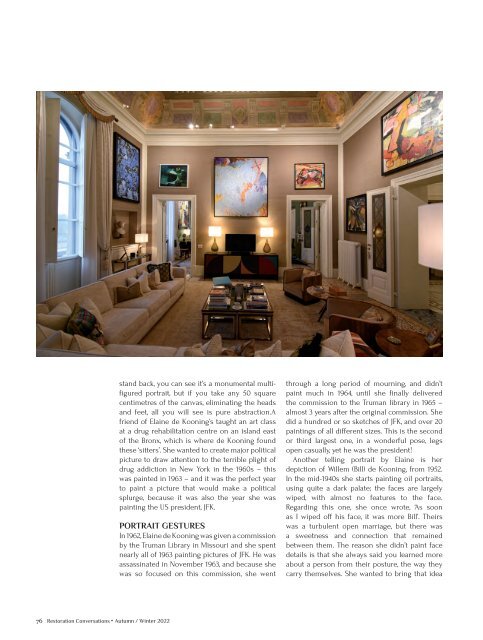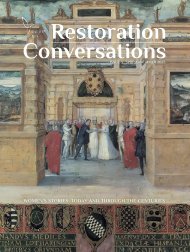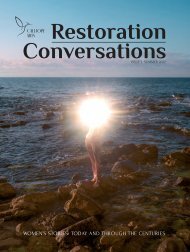Autumn/Winter 2022
Restoration Conversations is a digital magazine spotlighting the achievements of women in history and today. We produce two issues a year: Spring/Summer and Fall/Winter
Restoration Conversations is a digital magazine spotlighting the achievements of women in history and today. We produce two issues a year: Spring/Summer and Fall/Winter
You also want an ePaper? Increase the reach of your titles
YUMPU automatically turns print PDFs into web optimized ePapers that Google loves.
stand back, you can see it’s a monumental multifigured<br />
portrait, but if you take any 50 square<br />
centimetres of the canvas, eliminating the heads<br />
and feet, all you will see is pure abstraction.A<br />
friend of Elaine de Kooning’s taught an art class<br />
at a drug rehabilitation centre on an island east<br />
of the Bronx, which is where de Kooning found<br />
these ‘sitters’. She wanted to create major political<br />
picture to draw attention to the terrible plight of<br />
drug addiction in New York in the 1960s – this<br />
was painted in 1963 – and it was the perfect year<br />
to paint a picture that would make a political<br />
splurge, because it was also the year she was<br />
painting the US president, JFK.<br />
PORTRAIT GESTURES<br />
In 1962, Elaine de Kooning was given a commission<br />
by the Truman Library in Missouri and she spent<br />
nearly all of 1963 painting pictures of JFK. He was<br />
assassinated in November 1963, and because she<br />
was so focused on this commission, she went<br />
through a long period of mourning, and didn’t<br />
paint much in 1964, until she finally delivered<br />
the commission to the Truman library in 1965 –<br />
almost 3 years after the original commission. She<br />
did a hundred or so sketches of JFK, and over 20<br />
paintings of all different sizes. This is the second<br />
or third largest one, in a wonderful pose, legs<br />
open casually, yet he was the president!<br />
Another telling portrait by Elaine is her<br />
depiction of Willem (Bill) de Kooning, from 1952.<br />
In the mid-1940s she starts painting oil portraits,<br />
using quite a dark palate; the faces are largely<br />
wiped, with almost no features to the face.<br />
Regarding this one, she once wrote, ‘As soon<br />
as I wiped off his face, it was more Bill’. Theirs<br />
was a turbulent open marriage, but there was<br />
a sweetness and connection that remained<br />
between them. The reason she didn’t paint face<br />
details is that she always said you learned more<br />
about a person from their posture, the way they<br />
carry themselves. She wanted to bring that idea<br />
76 Restoration Conversations • <strong>Autumn</strong> / <strong>Winter</strong> <strong>2022</strong>





